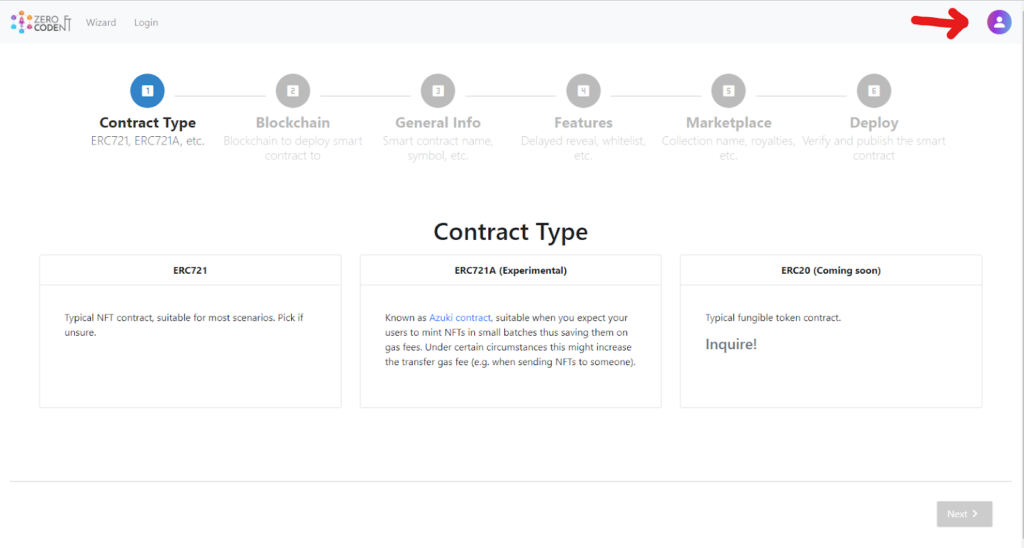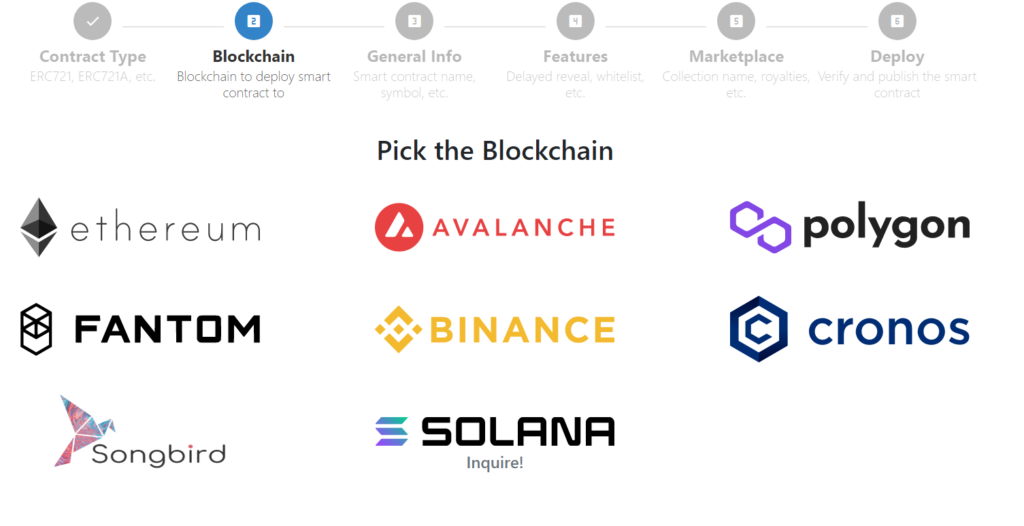
[ad_1]
Over the past couple of years, NFT sales have skyrocketed. The most expensive NFT is from Pak, sold for over $91 million, taking over Beeple’s Everyday ($69.3 million) by a considerable gap. One reason for such huge popularity is the easy ways of creating NFTs through various online tools. If you wish to get an even easier way of doing it, you should read this article.
We are introducing a revolutionary platform that lets you control your NFTs as if skilled developers coded them. Not bridging the suspense any further, we have bought you an article that will guide you through creating NFTs without coding in just 6 steps.
What is an NFT?
NFT(Non-Fungible Token) are art forms(pictures, audio, video, etc.) embedded in blockchain for security and authentication, allowing unique ownership.
If you ever wanted to create and sell your own NFTs but dropped the plan due to coding issues, this is your chance to sell your NFT Art. Zero Code NFT offers a unique platform that not only lets you mint your NFTando enables you to access advanced features like preview, pre-sales, whitelisting, wallet allowance, airdrop, and a lot more.
Also read, A Buzz Around Non-Fungible Tokens
Zero Code NFT
Ihor Bodnarchuk, a software engineer, founded zero Code NFT. The platform allows users to create customizable NFTs and enable them to control features like NFT numbers, allowing whitelisting, airdrops, and many other custom features. There are a lot of NFT generators, but most of them are best-suitable for amateurs. Zero Code NFT gives you control over your art like never before.
The platform requires one-factor login through wallets like Metamask. Once done, you can create lots of custom-made NFTs and offer features like a professional NFT organization. Another prime feature is that it allows NFT Art to be sold in marketplaces like OpenSea, helping people to access a wide range of customers.
Connecting Wallet
Connecting the wallet is very easy in Zero Code NFT. It feels like the website has been designed to keep a smooth user experience.
- Again click on the icon as shown below to connect your Metamask.
- Enter the password on your metamask plugin.
- Then it would ask for the following details: name, email, and referral code(optional).

Creating NFT in 6 Simple Steps
1. Select the contract type
First, you need to select the contract type(smart contract) which will hold your NFT. Smart contracts are executable code that work automatically when a specific condition is satisfied. In this case, accepting payments and transferring NFTs to the buyer’s account are such conditions.
Also read, Agreeable Smart Contracts

There are three options:
- ERC-721 is the most common and widely used standard of NFT. That NFT art created using this standard have each smart contract dedicated to each NFT. Unless you are an advanced user, we recommend that you do not select other contract types.
- ERC-721A: It is an experimental smart contract code that might have bugs or errors. Please test this standard with Ethereum’s test networks like Rinkeby to ensure smooth functionality before using. To save gas fees, developers and creators use it for NFT minting on small batches.
- ERC-20: It is a fungible smart contract standard and supports multiple NFTs valued differently. Zero Code NFT expects this feature to come soon on its platform.
2. Selecting the Blockchain
NFTs are available in many blockchains these days. Some of these blockchains are well-known, like Binance Smart Chain, Solana Blockchain, etc. If you do not have any preference, we recommend selecting Ethereum Blockchain(most used). You should also know that Polygon blockchain offers meagre gas fees.
Further clicking on the Solana blockchain takes you straight to email, which is quite weird considering there is no other information except inquire.

3. General Information
The general information step requires you to fill in the following 7 data points:
- IPFS Metadata URL: Inter-Planetary File System, IPFS is the repository where those files that have been converted into NFTs are stored. You must submit the complete file URL down to the last folder here.
- Name of the NFT: Select a name for your NFT collection.
- Collection Size: You can select the number of NFTs that will be part of this collection. It can be as low as 1. There appears to be no upper limit. For an NFT art gallery, choose the appropriate number. Or, in the case of different artworks, mint each one.
- Token Symbol: Select a symbol for the tokens.
- Mint Price: You can select the mint price based on the blockchain. Remember, the mint prices are in Blockchain Native Coins, not fiat currencies.
- Max NFTs per Person: Select the maximum numbers of NFTs that you want to allow per person. This field is an optional one.
- Max NFTs per Transaction: Select the maximum numbers of NFTs that you want to allow per transaction. It is essential to avoid gas wars. This field is also optional.
4. Features
All features in this section are optional, and selection depends upon the user. This section contains three elements, namely:
- Delayed Reveal: It allows buyers to reveal NFTs only when users mint them. This step helps in avoiding information or access to NFTs that are rare. Otherwise, minters will only mint rare NFTs if they can see all of them.
- Whitelist: This feature allows few wallet addresses to mint their NFTs before anyone so there is no gas war. There is a field where you can set presale or whitelisting prices.
- Split Revenue: This feature allows multiple users to earn income when they sell NFTs. You can also set which account will get how much share of the earnings after the sales.
5. Marketplace
This section contains six fields that you need to fill. Some are editable later on, such as collection name, description, etc., in NFT marketplaces like OpenSea.
- Marketplace: It is the secondary marketplace where you will sell your NFTs. For example, if you select Ethereum (like I did) on the Blockchain page, it will show the OpenSea NFT marketplace as the secondary marketplace. You can change it later.
- Collection Name: Name your collection, which will feature on OpenSea or the platform of your choice.
- Description: Enter a description of your project.
- Project URL: This is the URL users can access to know more about your NFT collection.
- Royalties: The creator receives a royalty for each sale in the secondary market. If you enter 10% as royalty, you will receive 10% of the transaction value for each subsequent sale.
- Royalties Recipient: Add the address where you want to get the royalties(funds) to be deposited.
Also Read: Best 5 FREE NFT Tools – Profit by Trading NFTs
6. Deploy
The deploy section is the final step. You are requested to verify all the details and edit them if required. Many things such as whitelisting addresses, beneficiary addresses, etc., should be checked at least twice to avoid permanent loss of funds.
NOTE: The metamask wallet, which you will use to pay the deployment fees, will acquire ownership of the NFTs.
Additional Feature
1. Lazy Mint:
Lazy Mint allows NFT Art creators to make buyers pay the fee for minting. With this, anyone can create an NFT art collection without the need for financing the initial deployment.
2. Pricing Plans:
There are three pricing plans available:
- Test Plan: Let you deploy NFTs on test networks such as Rinkeby in Ethereum blockchain. It also includes-
- Lazymint
- Royalties
- Whitelist
- Delayed Reveal
- Airdrop
- Smart Contract Panel
- Split Revenue
- Launch: $799. Everything in Test Plan plus-
- Zero Code NFT Collection.
- OpenSea Setup.
- Minting Page and Webpage build support(Wix, Elementor, WordPress).
- Technical and Launch day support.
- IPFS assistance.
- Charity: There is a 25% off for non-profit organizations. All features are available.
Conclusion
Zero Code NFT is a revolutionary platform in the world of NFTs. It will help new creators save a lot of money that creators spend on blockchain service providers. Further, this will encourage the adoption of NFT Financing as the primary method of selling artwork or financing art projects.
Frequently Asked Questions
How much is the gas fee to mint NFT in Ethereum?
Gas fees depend upon the network congestion and typically range from 0.05-025 Eth.
Can I change the NFT price after deployment?
A smart contract dashboard is given in the platform that lets you do that.
Can I get a trial?
The test plan is free and lets you access most of the significant features.
Also read,
[ad_2]
Source link





